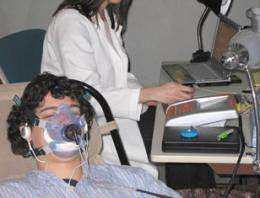Even mild immune reactions have significant energy costs, evolutionary anthropologist finds

The energetic costs of fighting off simple respiratory infections result in heightened resting metabolic rates and lower testosterone levels in men, an Indiana University anthropologist shows in research pointed toward quantifying how immunological burdens and trade-offs play a role in human evolution.
In a study that involved 25 young adult men infected with respiratory tract pathogens, IU Assistant Professor of Anthropology Michael Muehlenbein found that in the most extreme cases testosterone levels fell by more than 30 percent while resting metabolic rates (RMR) jumped by 14 percent. On average, the group experienced increased RMR rates of 8 percent and testosterone declines of 10 percent.
"The results document elevated RMR and lowered testosterone following natural pathogen exposure in adult humans, demonstrating that even mild immune reactions elicit significant increases in energy expenditure," Muehlenbein said of the research published in the July-August issue of the American Journal of Human Biology. "Understanding the costs of immunity and the immunomodulatory actions of hormones are central to understanding the role of immunity in human life history evolution."
RMR reflects the amount of energy used to maintain basic cell function and, while it is the largest component of daily energy expenditure, it does not take into account physical activity, digestion, responses to stress, or other additional activities. Sharp increases in RMR are often associated with equilibrium disturbances like surgery, trauma, certain types of vaccinations, and diseases like sickle cell anemia and cystic fibrosis.
Muehlenbein said human RMR typically increases from 7 percent to 15 percent for every one degree Celsius rise in body temperature during fever, and his research suggests that metabolic expenditure is "significantly increased" even when no fever accompanies infection.
"The metabolic responses to mild, acute infections and injury in humans have been relatively unexplored, despite the fact that much work in evolutionary anthropology relies on the assumption that immune maintenance and activation impose costs," Muehlenbein noted.
To better understand those costs could provide a string of benefits, including the use of RMR changes as biomarkers for quantifying disease severity and recovery, improving treatment plans for poorly modulated metabolism suffered during illness, and benefiting doctors who use hormone supplements in medical treatment.
Muehlenbein said the study lends some credence to the saying "feed a cold, starve a fever," in that different infectious agents require different responses.
"Given the energetic requirements of mounting immune responses against respiratory tract infections, as illustrated in this study, the proverb to 'feed a cold, starve a fever' may be appropriate advice," he said. "That is, fighting different pathogens may require plasticity (variation) in host behaviors."
More information: "Toward quantifying the usage costs of human immunity: Altered metabolic rates and hormone levels during acute immune activation in men," American Journal Of Human Biology: The Official Journal Of The Human Biology Association [Am J Hum Biol] 2010 Jul-Aug; Vol. 22 (4), pp. 546-56.
Provided by Indiana University
















